FAQ
General
RAMMS on Windows 11
August 19th 2024
Question:
Does RAMMS work on Windows 11?
Answer:
Yes, all modules of RAMMS run also on Windows 11!
RAMMS - URL Error - Update
July 12th 2024
Problem:
I get an error when I try to update RAMMS (Help -> Update… -> Web Update). What is going wrong?
Answer:
This is due to the transition of RAMMS from SLF to the new WSL-Spin-off company RAMMS AG. Some links do not work anymore.
Avalanche/Debrisflow:
Please update your version by doing the following:
- Download the update from here, and unzip the file to a local directory (e.g. C:\Temp\). Beware, there is another zip-file within the downloaded zip-file, do NOT unzip this file, otherwise the update will not work.
- Then start RAMMS and choose Help -> Update… -> Install Update from local folder.
- Select your local directory from before, where you unzipped the update.
- RAMMS should now tell you, that an update is available. Do NOT let RAMMS show you the changelog document, as this link also does not work. Click No.
- In the next window, RAMMS shows you your current version, and the update version. Click Yes to update your RAMMS version.
- You successfully installed the update. Restart RAMMS to use the new version.
Rockfall:
If you still use version 1.7.65, then please download the new version from here (Downloads section at the bottom of the page). Version 1.7.65 will not be updated anymore.
If you already use the new version 1.8.10 or higher, then you can download the update manually from here, and unzip it into your installation directory (replace all files).
From version 1.8.26 on, Web Update should work again as usual.
How do I create a license request file?
Did you already install RAMMS?
If No, you have to download and install RAMMS first, before proceeding to the next steps!
If Yes, then do the following:
Start RAMMS for the first time, and you will see the following screen, where you have to click the upper right button, to create the license request file:
Then choose a location to save the license request file (it’s a txt-file).
An informational window will then tell you where you saved your license request file. Attach this file when ordering a license (full, demo or student license).
Unable to allocate memory: to make array
February 2nd 2021
Problem:
I try to run a simulation, but instead of the results, I get the following error message:
Error-Messages:
Unable to allocate memory: to make array.
Not enough space
Execution halted at:
What is going wrong here?
Answer:
The following issues can have an influence on the memory management of RAMMS:
- Do you use a large ortho-image that you overlay? This could be the problem here. Reduce the resolution of your ortho-image and try again.
- Calculation domain: Do you use a narrow calculation domain? If not, please have a look in the manual on how to define an ideal calculation domain (for avalanche and debris flow simulations).
- Dump Step: By increasing the dump step, you decrease the amount of memory needed to open a simulation file.
- Simulation resolution: A very good (=small) simulation resolution increases the amount of memory needed to open a simulation file.
No map found, continue search?
October 25th 2021
Problem:
I have two tif-files, a topographic map and an orthophoto, but I don’t understand why they don’t appear in the program and why it says that it doesn’t find any map or orthophoto. What can I do?
Answer:
- Both topo map and orthophoto must be in the same coordinate system as the DEM you used to create the project in RAMMS.
- For topo map and orthophoto, you need the corresponding world-file (tfw-file) to the tif-file. Otherwise, RAMMS will not find the files.
Problem after updating to 1.8.0
Problem:
I updated RAMMS::Avalanche (or Debrisflow) to version 1.8.0, but now I cannot run any simulations. RAMMS is stuck with “Create .xy-file”, see Figure 1 below.
Solution 1:
Open the “Additional Preferences” (Help -> Advanced… -> Additional Preferences… -> Edit) and check, if you have the “X64” option set to 1 (see Figure 2 below). If you do not find this option, then just add a new line (before the END tag) and enter
X64 1
Then click “Save” and “OK” and try again to run a simulation. If this does not work, then most probably some C++ libraries are missing on your system. Please see solution 2 below.
Solution 2:
- Open RAMMS
- Then use the function “Install C++ libraries” (Help -> Advanced… -> Install C++ libraries) to install the libraries (you will need Admin privileges to do that).
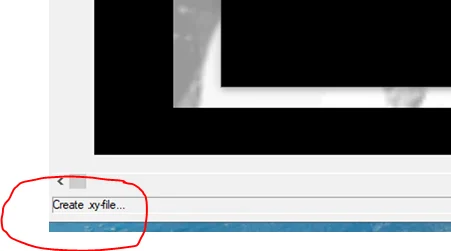
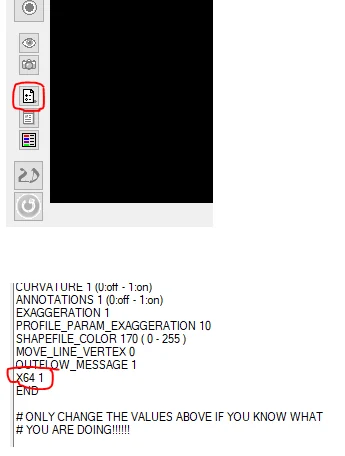
_JUSTCOMPUTEDRANGE is undefined…
Question:
I tried the new update, but when I try to open an old file, the following error message appears:
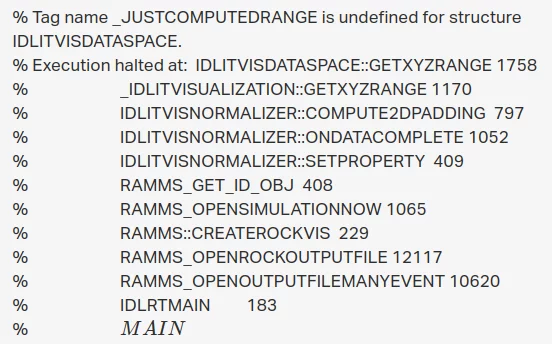
Can you help me?
Solution:
- close RAMMS
- remove this directory: “C:\Users\<your username>\.idl” (if you specified Preferences in RAMMS, then you have to re-set them)
- now you should be able to start and use the new version. I strongly suggest only to use the new version (Rockfall) from now on. The speed of the handling is much improved, much easier to use RAMMS!
- if you again use the old version (Rockfall), then this problem could happen again…….
Can I import DXF-files into RAMMS?
Answer:
Yes, you can, but this is work in progress. Please get in contact with us and we gladly help!
Avalanche
MuXi: Altitude limits, what do they represent?
Answer:
Friction parameters mu and xi are automatically calculated according to return period, avalanche volume, “track type” (flat, open slope, channelled and gully) and altitude. In the “Automatic MuXi Procedure” you can specify the altitude limits:
Altitude limit 1 is the upper limit, and altitude limit 2 the lower limit.
These limits will change the friction values according to the altitude, assuming, that the temperatures are higher in lower regions, and thus the snow characteristics are different (higher snow densities with higher temperatures, etc…).
- Upper limit: is normally below the tree line (in Switzerland, the tree line is around 1800m……we use 1500m as the upper limit)
- Lower limit: the lower limit could be seen as a “snow line”. In Switzerland this limit is normally 1000m.
Suggestions for altitude limits for different regions:
September 2nd 2024
What numerical solution technique does RAMMS use?
Answer:
In all RAMMS versions (Avalanche and Debrisflow) up to Version 1.5.01, an ENO (Essentially Non-Oscillatory) scheme was used to numerically solve the governing differential equations (Christen et al., 2010). However, the numerical solution was implemented on strictly orthogonal grids. This improves computational speed, but introduces numerical instabilities especially in steep terrain.
The new Version 1.6.20 uses the same second order ENO scheme, but now on general quadrilateral grid. This new scheme improves numerical stability, but slows the computational speed somewhat. The introduction of this stable ENO scheme allows us to use lower H_cutoff values minimizing mass loss during calculations. The standard value of H_cutoff is 0.000001 m.
When and why does the Voellmy model work well for Avalanches?
Answer:
Avalanches
The Voellmy model – coupled with the calibrated parameters – can be used to
- (1) predict the runout distance and
- (2) predict the maximum flow velocity of extreme, large snow avalanches.
This is one of the important research results from the Vallée de la Sionne test site. The Voellmy parameters that we recommend describe the front of a dry-snow avalanche. Because the front defines the runout distance and maximum velocity the Voellmy model will work.
However, the Voellmy model will not describe the avalanche flow behind the front, at the tail of the avalanche. Here, measurements show an increase in the friction (a rapid decrease in speed). This effect causes avalanches to elongate and eventually deposit mass. Therefore, the Voellmy model will not predict the deposition behaviour.
The Voellmy model has difficulties to predict the runout of small avalanches, which sometimes begin immediately to deposit or “to starve”. Of course, small avalanches can be modelled using higher μ and ξ values, but this is a very ad-hoc approach.
How long does it take to perform a simulation?
Answer
The time required to simulate an avalanche or a debris flow is a function of the finite volume grid resolution and the size of the calculation domain. Typically we use 5m resolutions and the simulations require around 10 minutes. We usually perform the initial simulations at 10 m resolution and therefore we have results in 1 or 2 minutes. When we have a solution that we like we might take a look at the problem at 2m resolution.
Rockfall
RAMMS ERROR: Planes must be parallel
October 25th 2021
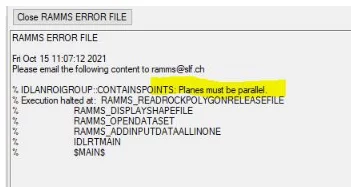
Problem:
I get an error when I import the shapefile of my release areas. What is going wrong?
Answer:
- The polygon shapefile most probably contains Z and M values. RAMMS does not like them 🙂
- Convert the shapefile to a polygon shapefile without Z and M values, and it will work.
Overhanging face
October 14th 2021
Question:
We have a query about the Zh-height value assumed in the calculations. The manual notes that Zh varies between 5m and 30m, with a default value of 30m, see Figure 1 below. We were therefore expecting to be able to specify a Zh in the calculation but can not see where we can do this. We therefore wondered if the open forest, medium forest and dense forest options assume different Zh values or if they assume the default value of 30m that we can not change.
The maximum tree height we are expecting is also less than 30m and is around 20 to 25 metres. Another reason we were looking to see if we can change the height.
Answer:
- The default Zh-value for all forest types is 30m.
You can change the Zh-value by doing the following:
- Open RAMMS
- click the “Additional Preferences” button (left vertical toolbar, at the bottom)
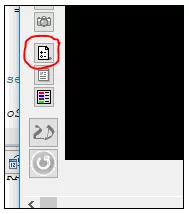
- and then add the following line (before the END keyword): SHOW_FOREST_PARAMS 1
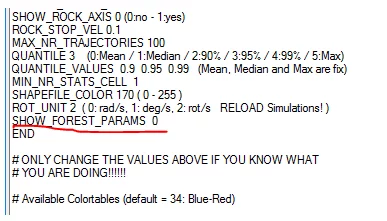
- then click ‘Save’ and ‘OK’, and open one of your input files. You should now be able to change the forest height values, see Figure 2 below.
Beware: you could also change the forest-drag-values. We suggest you use the default values from RAMMS. If you have good reasons to decrease or increase the drag values, this is the way to change the drag-values.
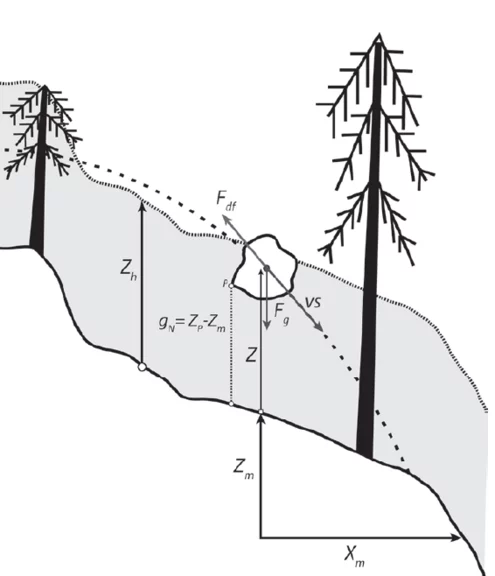

Debrisflow
Any advice on how to use the hydrograph?
August 26th 2024
Problem: What data do I need to model a debrisflow using a hydrograph?
Answer: You only need the hydrograph for the debris flow itself, not for the river flow from before or after the event. RAMMS can only predict the runout of debris flows (not the flood flows before or after the debris flow).
- The easiest way to run RAMMS using an input hydrograph is to start with an estimate of the total volume of the debris flow, which you may be able to estimate using other engineering methods or based on estimates from previous events in the area. When you enter this into the 3-point hydrograph table in the “Release Tab”, RAMMS will then propose a maximum discharge based on a semi-analytical relationship in the literature (as described in the handbook, from Figure 2 in Rickenmann (1999, Empirical Relationships for Debris Flows).
- If you only have an estimate of the maximum discharge, but not the total event volume, you could use the Rickenmann (1999) curve (mentioned above) and your maximum-expected discharge value to estimate the total debris-flow volume. You could do this either with the graph in Rickenmann (1999) or you could do this iteratively in RAMMS by adjusting the total volume until it matches your predicted maximum discharge value. This will give you the standard three-point hydrograph.
- If you have information that you trust regarding the expected duration of the peak discharge, you could also manually edit the hydrograph table.
As a reminder, the hydrograph volume in RAMMS (as well as the block release volume) is the sum of both the water and the sediment in the debris flow, not the pure-water discharge, so depending on the methods you are using, you may need to increase the volume of the flow to include the sediment in the flow, depending on your expected sediment concentration. To a first approximation, debris flows are roughly half water and half sediment (by volume), but you may already have a better estimate of the expected properties of the debris flows you are modelling.
How do I speed up my debrisflow simulation?
Problem: My debris flow simulation takes ages to calculate. I use a 0.5m resolution. Do you have any suggestions on how to speed up my simulation? And sometimes I get this error message:
Error-Messages:
Unable to allocate memory: to make array.
Not enough space
Execution halted at: RAMMS_OPENBINARYOUTPUT 2237
Answer:
There are several important issues that affect your simulation speed and also your (RAMMS) memory management:
- Dump Step: By increasing the dump step (when starting a simulation, e.g. 10s instead of 5s), you decrease the amount of memory needed to open a simulation file.
- Calculation domain: Do you use a narrow calculation domain? If not, please have a look in the manual (section 3.5.4) on how to define an ideal calculation domain.
- Simulation resolution: A very good (=small) simulation resolution increases the amount of memory needed to open a simulation file.
- Do you use a large ortho-image that you overlay? This could also be a memory problem. Reduce the resolution of your ortho-image (do not forget to change the .tfw file too) and try again.
Why use a hydrograph for debris flow modelling?
Answer:
There are several good reasons:
Firstly, hazard mitigation experts are often interested in the flow behaviour only near the fan. Calculating the movement of the debris flow in the torrent is a time consuming and often useless task. Therefore using a hydrograph can often cut calculation times dramatically.
Another reason is that it is impossible to describe the initial conditions of debris flows as a “block release”. There are cases where block release is a good approximation of reality (e.g. dam breaks), but, in general, it does not accurately reflect the starting conditions of flows from intense precipitation.
Read this publication for more information on this issue:
Deubelbeiss, Y.; Graf, C., 2013: Two different starting conditions in numerical debris-flow models – case study at Dorfbach, Randa (Valais, Switzerland)
When and why does the Voellmy model works well for Debrisflows?
Answer:
Debris flow
The “best” constitutive model for debris flows is still a very open question in the scientific community. We recommend using the Voellmy model until a better model is found. Voellmy basically has only two parameters and after some calibration a useful solution can usually be found. With Voellmy one can control the flow velocity (parameter xi) and runout distance (mu).
One reason Voellmy is useful is that it only requires two parameters to calibrate. The turbulent term dominates the frictional behavior when the flow is moving rapidly and the Coulomb term is dominant when the flow is moving slowly, allowing the model to be approximately calibrated to observations of flow velocity and the stopping location of the flow front.
Finding the “right” debris flow model is more difficult than finding the “right” snow avalanche model because debris flows are two component systems (fluid, solid). Much of the behaviour of a debris flow — including the stopping process — involves the interaction between the fluid-solid components. Thus, without a two component model, it will be unlikely that we are able to model all aspects of debris flows. The Voellmy model mixes the two components and therefore models the debris flow when the components volumes are constant and well mixed. This assumes, of course, that the relative portions of solid and fluid remain the same, from head to tail of the event. This is hardly true
How does erosion work?
Answer:
Erosion is explained in on this page.
Shop
Can I pay with credit card?
Yes, you can 🙂
When you select products in the shop, add them to the cart, then view the cart and proceed to checkout. There you will find the option to pay by credit card:
August 26th 2024
Do I have to pay additional taxes?
Only Swiss customers have to pay the Swiss taxes (MwSt).

